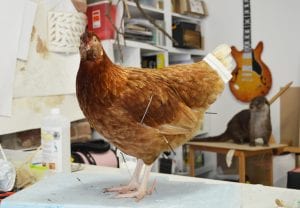Specimen of the Week 309: Taxidermy Chicken
By Dean W Veall, on 22 September 2017
Hello Specimen of the Week readers, Dean Veall here. This week I have chosen a specimen that is a newly acquired piece of taxidermy which features in our latest blockbuster exhibition The Museum of Ordinary Animals which opened this week. It’s an animal that has a staggering population of 19 billion individuals, Specimen of the Week 309 is the…..
***Taxidermy chicken (Gallus gallus domesticus)***
An ordinary animal
Chickens are ubiquitous in our lives today and are thought to be one of the most widespread domestic animals on the planet. Despite their great number their relationship with us isn’t that old, chickens were thought to have been first domesticated around 4,000-6,000 years ago from Asian red jungle fowl (Gallus gallus) thought to have been attracted to human villages in the Indus Valley in South Asia by waste from crop-processing and animal dung. Since their domestication our relationship with these birds has been complicated, with their cultural significance being more than just a source of food, from Chinese zodiac to to Christian iconography through a Papal decree in the sixth century to Victorian entertainment in cock-fighting. This recent film by PBS America illustrates wonderfully the place chickens have in our hearts:
The origins of battery chickens
Professor Mark Thomas, one of the 18 researchers who tell the stories of ordinary animals in our new exhibition, believes the genetic origins of battery chickens can be traced back to a Benedictine decree:
Ancient DNA from archaeological remains shows that 1,000 years ago certain genes became widespread which caused chickens to lay eggs year-round, and be less aggressive to each other, enabling them to be kept together in small spaces. Their bones become more common at this point too, signalling that humans started eating more chickens.
These genetic and archaeological events closely follow the timing of a decree by Benedictine monks, instructing Christians to stop eating meat from four-legged animals during times of fasting. Birds – including chickens – and their eggs were allowed.
Life and afterlife of Chickerina
Unlike many of our historic taxidermy specimens that featured in our recent Fluff it Up conservation campaign, we know a lot about the life of our our new chicken spceimen (affectionately named Chickerina by our Curator). Even though we don’t know the exact age, based on her physical condition at the time of death we believe she died from old age in May 2017. She was living out her old age in at a free range poultry rescue farm in Brighton with other chickens and ducks many of whom were rescued from battery farms. When she died, she was donated to by RSPCA Patcham to ethical taxidermist Jazmine Miles-Long, who we then commissioned to create the new taxidermy for The Museum of Ordinary Animals.
The Grant Museum has a jam-packed collection of over 68,000 specimens and, like most accredited museums, has policies and procedures in place to acquire new specimens. In order to justify the acquisition to our oversight committee we did a bit of research and discovered (quite surprisingly, but actually not that surprising) that chickens are actually rare museum display specimens and were even once told by an inside source from a major national museum that we had the only chicken skeleton on display in the whole of London….!
This latest addition to the collection will be a great asset to the Museum, helping to illustrate the changing nature of taxidermy, being a good counter to some of our more historic (and occasionally) less-than-100%-accurate taxidermy specimens.
Ethical taxidermy
Jazmine Miles-Long is an ethical taxidermist, only using specimens that died of natural circumstances or from historic collections. Check out this great video of her drying the recently skinned Chickerina:
The Museum of Ordinary Animals runs from 21st September to 22nd December. A number of events accompany the exhibition: through discussions, a late opening, a comedy night and offsite events discover how boring beasts shape our relationship with the natural world. Full details are on the exhibition’s website.
Dean Veall is Learning and Access Officer at the Grant Museum of Zoology.
 Close
Close




